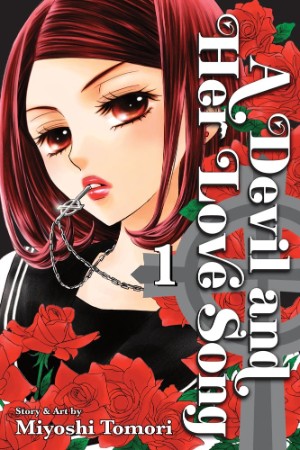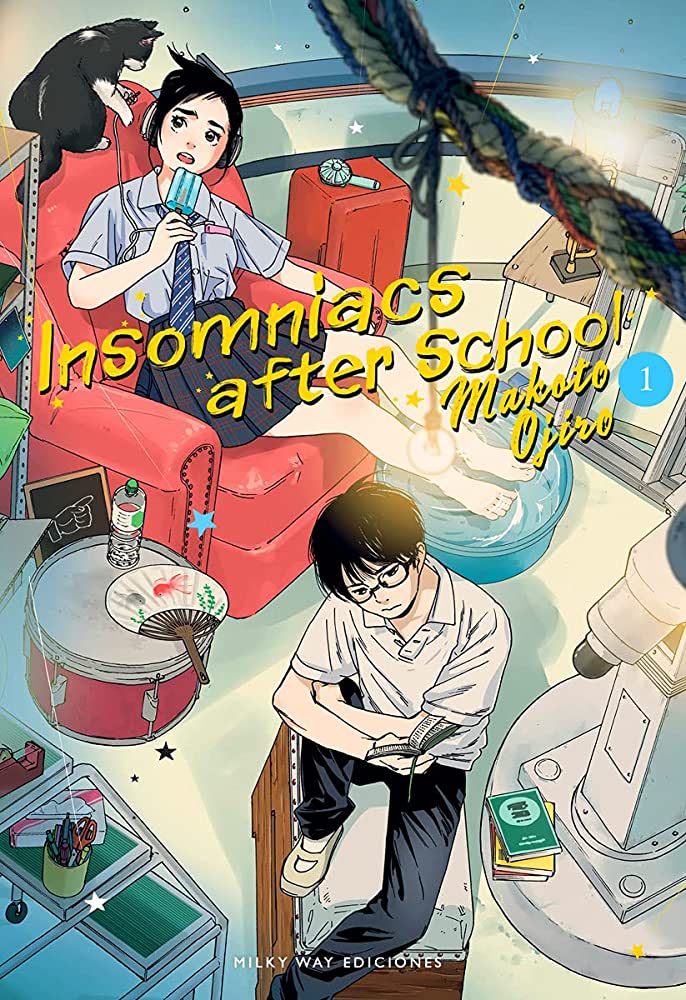Maria Kawai, heroine of A Devil and Her Love Song, is a cool customer. Not only is she beautiful, talented, and smart, she’s also tough — so tough, in fact, that she was expelled from a hoity-toity Catholic school for beating up a teacher. Her blunt demeanor further cements her bad-girl impression; within minutes of enrolling at a new high school, she antagonizes all the girls in her class with a few sharp observations about their behavior. Only two boys — Yusuke, a cheerful, popular student who avoids conflict at all costs, and Shin, a moody outsider — try defending Maria from her peers’ nasty comments and pranks.
So far, so good: Maria is spiky and complicated, a truth-teller who lacks the ability to censor herself, even though she’s aware of the potential consequences of speaking her mind. Throughout volume one, there are some wonderful comic moments as Maria struggles to put a “lovely spin” — Yusuke’s term — on her acid comments. Alas, Maria’s sideways head-tilt and doe-eyed gaze look more sinister than cute; not since Kazuo Umezu’s Scary Book has a manga-ka made a doll-like character look so thoroughly menacing, even when superimposed atop a backdrop of flowers and sparkles.
Having created such a vivid character, however, Miyoshi Tomori isn’t sure where to go with the story. In several scenes, Maria does things that contradict what we know about her: would someone as perceptive as Maria willingly attend a party hosted by the class mean girls, especially after they’d harassed her on a daily basis? And why would someone as outspoken as Maria refrain from pointing out her teacher’s judgmental behavior — especially when it’s plainly obvious to both the characters in the story and the reader? These kind of abrupt reversals might make sense if we knew more about Maria’s past, but at this stage in the story, they feel more like authorial floundering than a conscious revelation of character.
From time to time, however, Tomori convincingly hints at Maria’s softer side. Midway through volume one, for example, Maria makes tentative overtures towards Tomoya “Nippachi” Kohsaka, a fellow bullying victim. (“Nippachi” means “twenty-eight,” and is a mean-spirited reference to Tomoya’s poor academic performance.) That scene is both sad and real; anyone who’s ever seen two ostracized kids turn their classmates’ scorn on one another will immediately appreciate the dynamic between Maria and Nippachi. Maria’s exchanges with Shin, too, reveal a different side of her personality; though the pair frequently engage in the kind of rapid, antagonistic banter that’s de rigeur for romantic comedies, their quieter conversations suggest a grudging mutual respect.
Maria’s interactions with Nippachi and Shin fill me with hope that A Devil and Her Love Song will find its footing in later chapters. If Tomori can find a way to reveal Maria’s fundamental decency without compromising her heroine’s tart, outspoken personality, A Devil and Her Love Song will be a welcome addition to the Shojo Beat catalog, an all-too-rare example of a story in which the heroine isn’t the least bit concerned with being nice or popular. If Tomori can’t, Devil runs the risk of devolving into a YA Taming of the Shrew, with Shin (or, perhaps, Yosuke) playing Petruchio to Maria’s Katherina.
Review copy provided by VIZ Media, LLC. Volume one will be released February 7, 2011.
A DEVIL AND HER LOVE SONG, VOL. 1 • BY MIYOSHI TOMORI • VIZ MEDIA • 200 pp. • RATING: TEEN (13+)




Noura says:
Thanks for the review. I will be picking this one up when it comes out. Hopefully it doesn’t turn out to be one of those typical shoujo series.
Katherine Dacey says:
A lot depends on whether the author plans to “tame” her heroine, or makes the other characters adapt to Maria. If she chooses the latter tact, I think Devil and Her Love Song will be a winner.
Aaron says:
Yeah that’s the thing I don’t want to see the female lead go from being tart and observant to a “Mary Sue” because the author doesn’t know how to write convincing character development.
Odd comparison but I thought Toradora did a good job of softening Tagia with ou making her a complete dish rag
Estara says:
I thought the love story gets somewhat clichéd, but the interactions in the classroom and Maria’s slowly developing self-confidence make this a favourite school drama romance of mine. In the last chapters I read (round about volume 6 or 7) the drama of romantic choice was ramped up to not very believable levels, but I hope the mangaka manages to steer through those choppy waters without completely taking away the very good character development before then.
Especially Yusuke gets a lot of space for reflection on himself.
In many ways THE central theme of this series is all kinds of peer pressure and how various people develop strategies for that – or not. And whether conforming or staying true to yourself is the best choice.
Katherine Dacey says:
Hi, Estara! Thanks for the low-down on later chapters. It will be very interesting to see if and how my opinion of the series changes over time. I’m definitely keeping an open mind about Devil and Her Love Song.
Estara says:
That’s all I could ask for ^^.
Olivia says:
It’s interesting reading a different point of view. I actually thought both the karaoke scene, and the part with the teacher, were explained nicely. I felt that Maria was genuinely trying to become a person that gets along with others, even if it’s not in her nature. Thus, when she went to the karaoke session, she tried to shut out her intuition and believe in the people around her instead, the way somebody normal might. (Even though it clearly didn’t work). And during the part where the teacher insults Maria, Shin realizes that she’s in a daze because of the pain in her foot, which is why she isn’t replying.
Katherine Dacey says:
Hi, Olivia — thanks for offering an alternative reading of those scenes. Intelligent discussion is always appreciated!
I’ll be honest: I went back and forth in my assessment of those scenes. In one draft of the review, I was more praiseworthy; in another, I was more strident in my criticism. I will definitely be re-reading volume one in preparation for reviewing the second volume, however, so I’ll keep your comments in mind as I do so.
starsamaria says:
A Devil and Her Love Song seems a little like Boys Over Flowers, which is my favorite series, so I’m definitely curious to check it out. The fact that they both ran in Margaret and feature tough heroines certainly helps me connect the two titles.
lovelyduckie says:
For now, I’ll pass. I’m much interested in making Dawn of the Arcana or 13th Boy my next shoujo series.